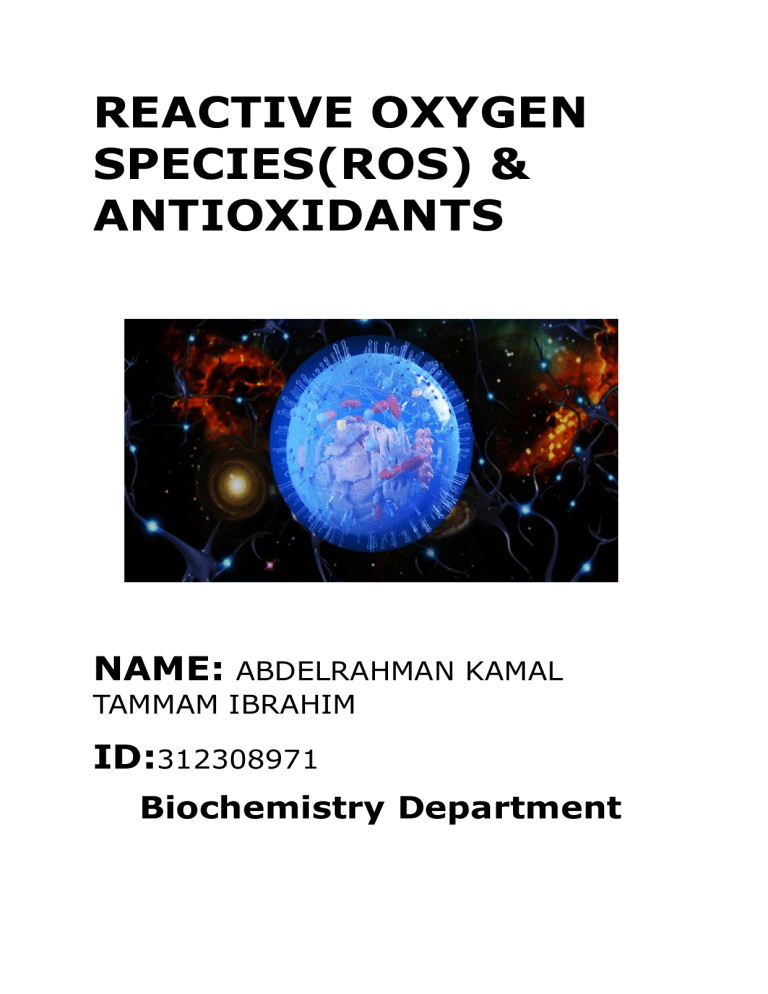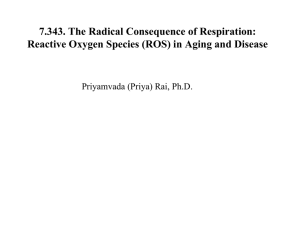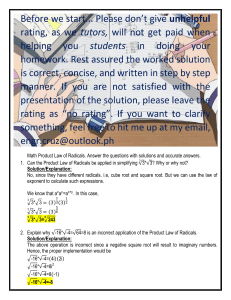
REACTIVE OXYGEN SPECIES(ROS) & ANTIOXIDANTS NAME: ABDELRAHMAN KAMAL TAMMAM IBRAHIM ID:312308971 Biochemistry Department ■Definition They are highly reactive molecules, free radicals derived from oxygen molecule with strong oxidizing power. ●Free radicals: are molecules with at least one unpaired electron in its outer shell. ■Types of ROS ROS are classified into two major categories of compounds which includes the free radicals and the non-reactive radicals. The free radical includes nitric oxide radical (NO•), hydroxyl radical (OH•), superoxide ion radical (O•2), peroxyl (ROO•), alkoxyl radicals (RO•), and one form of singlet oxygen (1O2). These species are considered as free radicals since they contain at least one unpaired electron in the shells around the atomic nucleus which makes them unstable and therefore can easily donate or obtain another electron to attain stability. As such, they are highly reactive and capable of independent existence. On the other hand, the non-reactive radicals are a group of compounds which are not radicals but are extremely reactive or can easily be converted to reactive species. Examples of these substances include hypochlorous acid (HClO), hydrogen peroxide (H2O2), organic peroxides, aldehydes, ozone (O3), and O2. ●Hydroxyl radical: is generated by Fenton reaction of hydrogen peroxide with ferrous compounds and related reducing agents. ●Superoxide: is produced by reduction of oxygen. ●Hydrogen peroxide: is also produced as a side product of cellular respiration. ●Singlet oxygen: is produced from dismutation of hydrogen peroxide or by reaction of ozone with other biomolecules. ●peroxynitrite: results from reaction of superoxide and nitric oxide. ●Nitric oxide: is synthesized from L-arginine by family of enzymes called nitric oxide synthase. ■Sources of ROS 1)Endogenous sources: ➢ By-products of metabolic pathways (respiratory chain, cytochrome P450 system, phagocytosis and prostaglandin synthesis). ➢ Functional generation by host defensive cells. ➢ During inflammation. 2)Exogenous sources: ➢ Radiation ➢ Smoking ➢ Heat ➢ Drugs or xenobiotics ➢ Ultraviolet irradiation ➢Environmental pollutants ■Beneficial effects of ROS ➢ Essential for normal physiological functions like: gene expression & cellular growth. ➢ As stimulating agents for biochemical processes within the cell. ➢ Participates in biosynthesis of molecules such as: thyroxine and prostaglandin ➢ Macrophages and neutrophils generate ROS in order to kill bacteria that are engulfed by phagocytosis. ■Harmful effects of ROS ➢ Damage of DNA or RNA (ROS can interact with it to cause several types of damages which include double- and single- DNA breaks, modification of DNA bases, loss of purines (apurinic sites), DNA-protein cross-linkage, damage to the deoxyribose sugar and damage to the DNA repair system). ➢ Oxidation of polyunsaturated fatty acids in lipids (lipid peroxidation). ➢ Oxidation of amino acids in protein (Following interaction with ROS, proteins can undergo direct damages such as damaging specific amino acid residues and changing their tertiary structures and indirect damages such as peroxidation, degradation and fragmentation. The consequences of protein damage include loss of enzymatic activity and altered cellular functions). ➢ Oxidative deactivation of specific enzymes by oxidation of co-factors. ➢ Damage of myelin sheath. ■The protective mechanisms of your body to combat ROS (Antioxidants) In response to the prevailing level of free radicals both from exogenous and endogenous sources, the human body developed a defense mechanism for protection against cellular damages. These may involve direct and indirect mechanisms put in place by the body. ●Indirect defense mechanisms: Firstly, the indirect mechanisms are those mechanisms that do not directly act on the free radicals to eliminate them or convert them to less reactive forms. Rather this indirect system can act in several ways. Certain regulatory mechanisms can control and regulate processes that lead to the endogenous production of ROS. This may be transcriptional control of the enzymes that are involved in the generation of endogenous ROS. Another indirect approach consists of certain molecules and enzymes that are transported to oxidative-damage sites for repair of macromolecules. This may include repair of damage DNA, protein or lipids. Also, certain molecules that can donate hydrogen atoms to damaged molecules are also considered as repair compounds. Molecules such as ascorbate or tocopherol can donate hydrogen atom to a fatty acid radical on cell membrane thereby repairing the membrane. Certain natural cellular or surface barriers such as the skin or cell membranes act as indirect defence system against ROS by preventing exogenous ROS from entering the body or preventing certain endogenous ROS from reaching the target macromolecules. ●Direct defense mechanism: This category of defence system which constitutes the antioxidant system is the most important because they directly act on free radicals either by decomposing, scavenging or converting free radicals to less reactive forms. This defence mechanism constitutes two groups; the enzymatic and non-enzymatic antioxidants. 1)Enzymatic antioxidants: The enzymatic antioxidants include superoxide dismutase (SOD), catalase, glutathione reductase (GRx) and glutathione peroxidase (GPx). ☆Catalase: It catalyzes the conversion of hydrogen peroxide to water and oxygen in two stages: Stage 1: Catalase–Fe (III) + H2O2 → compound I Stage 2: Compound I + H2O2 → catalase–Fe (III) + 2H2O+O2 2)non-enzymatic antioxidants: The non-enzymatic antioxidants are usually low-molecular-weight antioxidant (LMWA) compounds capable of preventing oxidative damage either by directly interacting with ROS or indirectly by chelating metals. ☆Vitamin E: it protects the unsaturated fatty acids PUFAS from peroxide, reacts and acts as a scavenger and gets itself oxidized to quinone formed by free radicals. Vitamin E is Essential for the membrane structure and integrity of cell. References • Lippincott Illustrated Reviews: Biochemistry, 8th Edition • https://www.ncbi.nlm.nih.gov/books/NBK299057/#ch1_sec1 • https://nyaspubs.onlinelibrary.wiley.com/doi/full/10.1111/j.17496632.1999.tb07814.x • https://aacrjournals.org/cancerres/article/54/7_Supplement/1890s/50107 0/Reactive-Oxygen-Species-in-Tumorigenesis1



